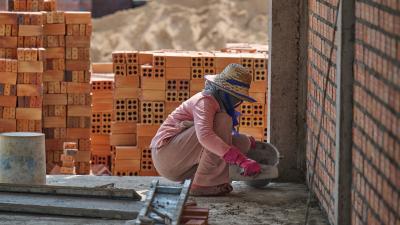
New technologies to improve health and safety performance
Discovering Safety joins forces with Safetytech Accelerator to build a Smarter Regulation Sandbox.
This page is approximately a 3 minute read
This page was published on

According to a report from Lloyd’s Register Foundation’s new Global Safety Evidence Centre, workers across numerous industries are increasingly at risk from harm posed by excessive heat, UV radiation, extreme weather events and other direct and indirect risks.
The Foundation’s World Risk Poll shows that one in five workers globally (18%) experienced harm at work in the last two years. The International Labour Organisation (ILO) estimates workplace harm to be the cause of three million deaths annually. 1
Climate change impacts threaten to increase this rate of harm, and rising temperatures are one of the areas of concern the report outlines. Extreme heat exposure increases the risk of work injuries by 1% for every 1°C increase, and 17.4% in heatwaves, especially in subtropical climates. The effects of extreme heat have already been felt across Europe this year, with Portugal, Spain, France and Italy facing temperatures above 40°C. 2Similarly, Southeast Asia has experienced a period of extended and usual heat in 2025, with temperatures in the Philippines reaching between 42°C and 51°C. 3 The report states that outdoor workers in agriculture and construction, as well as indoor workers, especially in poorly ventilated environments, are most affected by excessive heat.
While workers across all industries face a host of direct and indirect risks as a result of climate change, including UV radiation and extreme weather events, those in already high-hazard industries including construction, manufacturing, and agriculture are highlighted as particularly at risk. This is especially the case for those in low- and middle-income countries.
However, the report highlighted the lack of research and evidence when it comes to climate-related risks. In areas where data does exist, the report outlines, it is often limited to one sector or region and doesn’t examine workers in different contexts, prompting the Foundation’s global call for more research and knowledge sharing.
Nancy Hey, Director of Evidence and Insight at Lloyd’s Register Foundation, said: “As the effects of climate change continue, the impact on work is also changing. This affects all of us, but some sectors and geographies stand to be more affected than others.
“As this report highlights, there is a lack of evidence on how to protect workers from these growing risks, particularly in low- and middle-income countries. Filling these gaps in knowledge should be an urgent priority – this work will enable lives and livelihoods to continue safely, and is essential to a thriving global economy.
“Where there is already strong evidence, as with risks from heat and UV radiation, then clear guidelines for employers should be created and widely shared. Researchers, evidence brokers and safety practitioners all have a role to play, and bringing these stakeholders together to share knowledge across sectors and regions will be key to protecting workers from the risks posed by climate change.”
The publication of the Foundation’s report coincides with a white paper from the Institution of Occupational Safety and Health (IOSH), which calls for the development and enforcement of climate-related safety regulations as part of existing labour laws.
Ruth Wilkinson, Head of Policy and Public Affairs at IOSH, said: “The impacts of climate change are already being realised. Action to address climate change needs to happen at multilateral, national and local levels, including with businesses. As part of this collective global action, it’s crucial we consider the impacts on people, and specifically on workers and those vulnerable worker groups, so that adaptation and mitigation measures can be taken. So, we all have a role to play, we need to work together to share knowledge and learning, and take action to manage the risks. Action needs to be taken, and fast."
This report discusses how climate change affects worker safety in different sectors around the world, and the evidence gaps that still need to be filled.
Download The impact of climate change on safety at work (briefing) (PDF, 4.14MB)